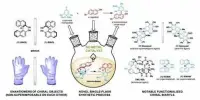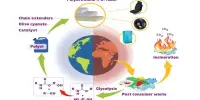Engineers have created a battery out of cheap, abundant materials that could provide low-cost backup storage for renewable energy sources. The new architecture, which is less expensive than lithium-ion battery technology, employs aluminum and sulfur as electrode materials, with a molten salt electrolyte in between.
As the world expands its wind and solar power installations, there is an increasing demand for cost-effective, large-scale backup systems to provide power when the sun goes down and the air is calm. Most such applications are still too expensive for today’s lithium-ion batteries, and other options, such as pumped hydro, require specific topography that isn’t always available.
Researchers at MIT and elsewhere have now developed a new type of battery that is entirely made of abundant and inexpensive materials, which could help to fill that gap. The new battery architecture, which employs aluminum and sulfur as electrode materials with a molten salt electrolyte in between, is described in Nature by MIT Professor Donald Sadoway and 15 other researchers from MIT, China, Canada, Kentucky, and Tennessee.
“I wanted to invent something that was better, much better, than lithium-ion batteries for small-scale stationary storage and, eventually, automotive [uses,” Sadoway, the John F. Elliott Professor Emeritus of Materials Chemistry, explains.
In addition to being expensive, lithium-ion batteries contain a flammable electrolyte, making them less than ideal for transportation. So, Sadoway started studying the periodic table, looking for cheap, Earth-abundant metals that might be able to substitute for lithium. The commercially dominant metal, iron, doesn’t have the right electrochemical properties for an efficient battery, he says. But the second-most-abundant metal in the marketplace – and actually the most abundant metal on Earth – is aluminum. “So, I said, well, let’s just make that a bookend. It’s gonna be aluminum,” he says.
The heat generated by charging keeps the salt from freezing. Then, when you discharge, you generate heat. When the sun is shining, you store electricity, and then you draw electricity after dark, and you do this every day. And that charge-idle-discharge-idle cycle generates enough heat to keep the thing warm.
Professor Donald Sadoway
The next step was deciding what to pair the aluminum with for the other electrode, as well as what kind of electrolyte to put in between to carry ions back and forth during charging and discharging. Because sulfur is the least expensive of all nonmetals, it was chosen as the second electrode material. Sadoway says that for the electrolyte, “we were not going to use the volatile, flammable organic liquids” that have sometimes caused dangerous fires in cars and other applications of lithium-ion batteries.
They tried some polymers but ended up looking at molten salts with relatively low melting points – close to the boiling point of water, as opposed to nearly 1,000 degrees Fahrenheit for many salts. “Once you get down to near body temperature, it becomes practical” to make batteries that don’t require special insulation and anticorrosion measures, he says.
The three ingredients they ended up with are cheap and readily available — aluminum, no different from the foil at the supermarket; sulfur, which is often a waste product from processes such as petroleum refining; and widely available salts. “The ingredients are cheap, and the thing is safe — it cannot burn,” Sadoway says.
In their experiments, the team showed that the battery cells could endure hundreds of cycles at exceptionally high charging rates, with a projected cost per cell of about one-sixth that of comparable lithium-ion cells. They showed that the charging rate was highly dependent on the working temperature, with 110 degrees Celsius (230 degrees Fahrenheit) showing 25 times faster rates than 25 C (77 F).

Surprisingly, the molten salt chosen as an electrolyte by the team solely because of its low melting point turned out to have a fortuitous advantage. Dendrites are narrow spikes of metal that form on one electrode and eventually grow across to contact the other electrode, causing a short-circuit and reducing efficiency. But, as it happens, this particular salt is very effective at preventing that malfunction.
Sadoway explains that the chloro-aluminate salt they used “essentially retired these runaway dendrites while also allowing for very rapid charging. We carried out experiments at extremely high charging rates, charging in less than a minute, and we never lost cells due to dendrite shorting.”
“It’s funny,” he says, because the whole focus was on finding a salt with the lowest melting point, but the catenated chloro-aluminates they ended up with turned out to be resistant to the shorting problem. “If we had started off with trying to prevent dendritic shorting, I’m not sure I would’ve known how to pursue that,” Sadoway says. “I guess it was serendipity for us.”
Furthermore, the battery does not require an external heat source to operate. Heat is produced naturally electrochemically by the charging and discharging of the battery. “The heat generated by charging keeps the salt from freezing. Then, when you discharge, you generate heat” Sadoway claims. For example, in a typical load-leveling installation at a solar generation facility, “When the sun is shining, you store electricity, and then you draw electricity after dark, and you do this every day. And that charge-idle-discharge-idle cycle generates enough heat to keep the thing warm.”
This new battery formulation, he claims, would be ideal for installations the size of a single home or small to medium business, producing a few tens of kilowatt-hours of storage capacity.
Other technologies, such as the liquid metal batteries Sadoway and his students developed several years ago and which formed the basis for a spinoff company called Ambri, which hopes to deliver its first products within the next year, may be more effective for larger installations, up to utility scales of tens to hundreds of megawatt hours. Sadoway was recently awarded this year’s European Inventor Award for that invention.
The smaller size of the aluminum-sulfur batteries would also make them suitable for applications such as electric vehicle charging stations, according to Sadoway. “If you try to do that with batteries and you want rapid charging, the amperages are just so high that we don’t have that amount of amperage in the line that feeds the facility,” he says, referring to when electric vehicles become common enough on the roads that several cars want to charge up at the same time, as happens today with gasoline fuel pumps. Having a battery system like this to store power and then quickly release it when needed could eliminate the need for expensive new power lines to serve these chargers.
















